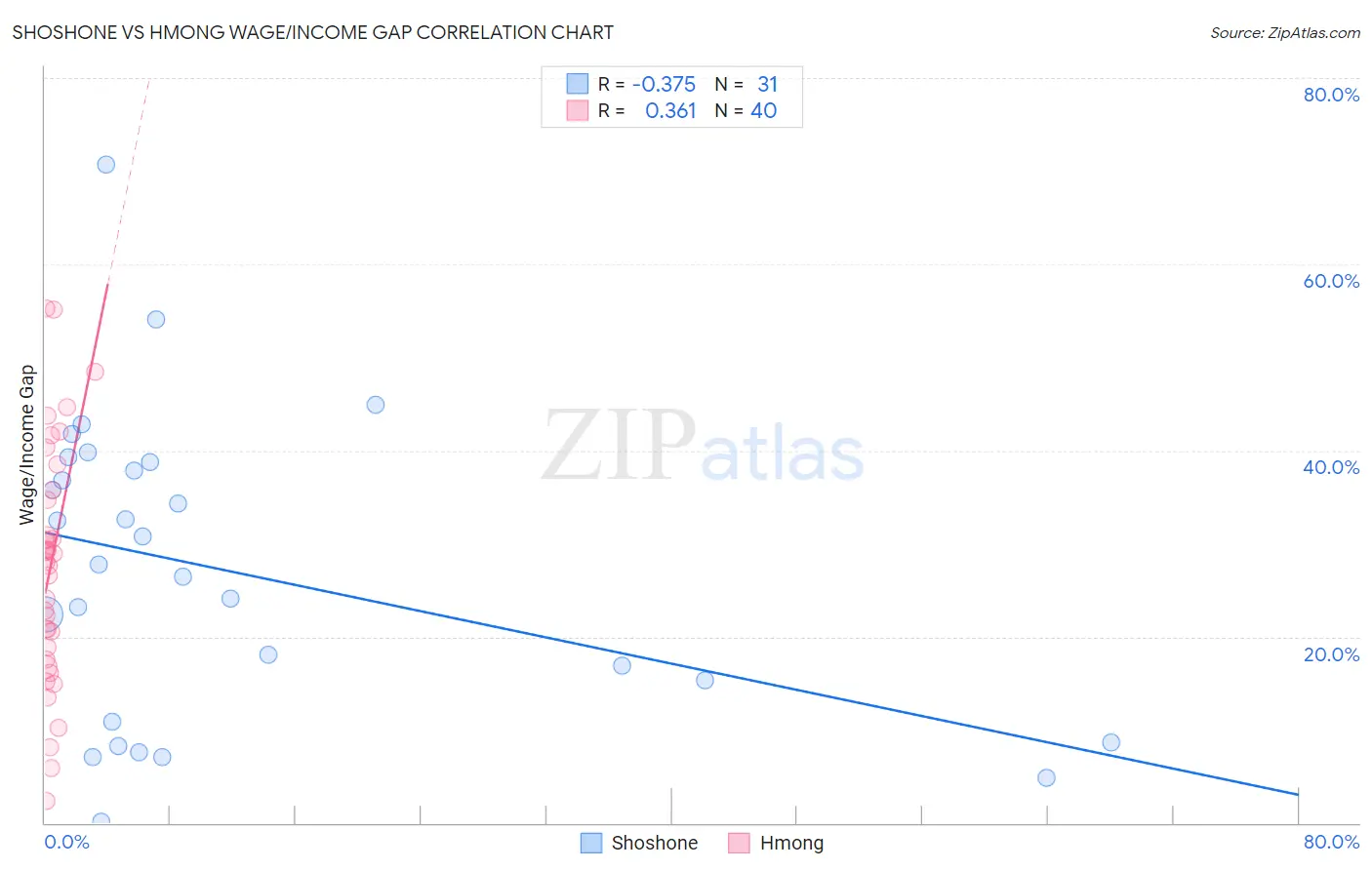Shoshone vs Hmong Wage/Income Gap
COMPARE
Shoshone
Hmong
Wage/Income Gap
Wage/Income Gap Comparison
Shoshone
Hmong
25.4%
WAGE/INCOME GAP
69.0/ 100
METRIC RATING
162nd/ 347
METRIC RANK
27.7%
WAGE/INCOME GAP
1.0/ 100
METRIC RATING
266th/ 347
METRIC RANK
Shoshone vs Hmong Wage/Income Gap Correlation Chart
The statistical analysis conducted on geographies consisting of 66,601,333 people shows a mild negative correlation between the proportion of Shoshone and wage/income gap percentage in the United States with a correlation coefficient (R) of -0.375 and weighted average of 25.4%. Similarly, the statistical analysis conducted on geographies consisting of 24,681,537 people shows a mild positive correlation between the proportion of Hmong and wage/income gap percentage in the United States with a correlation coefficient (R) of 0.361 and weighted average of 27.7%, a difference of 8.9%.

Wage/Income Gap Correlation Summary
| Measurement | Shoshone | Hmong |
| Minimum | 0.19% | 2.4% |
| Maximum | 70.8% | 55.2% |
| Range | 70.6% | 52.9% |
| Mean | 27.1% | 27.5% |
| Median | 27.8% | 28.4% |
| Interquartile 25% (IQ1) | 10.8% | 18.2% |
| Interquartile 75% (IQ3) | 38.7% | 35.2% |
| Interquartile Range (IQR) | 27.9% | 17.0% |
| Standard Deviation (Sample) | 16.3% | 12.7% |
| Standard Deviation (Population) | 16.1% | 12.6% |
Similar Demographics by Wage/Income Gap
Demographics Similar to Shoshone by Wage/Income Gap
In terms of wage/income gap, the demographic groups most similar to Shoshone are Native Hawaiian (25.4%, a difference of 0.0%), Albanian (25.4%, a difference of 0.030%), Korean (25.4%, a difference of 0.040%), French American Indian (25.4%, a difference of 0.28%), and Puget Sound Salish (25.3%, a difference of 0.32%).
| Demographics | Rating | Rank | Wage/Income Gap |
| Immigrants | Vietnam | 77.7 /100 | #155 | Good 25.2% |
| Immigrants | Mexico | 76.4 /100 | #156 | Good 25.3% |
| Costa Ricans | 75.8 /100 | #157 | Good 25.3% |
| Immigrants | Zimbabwe | 73.7 /100 | #158 | Good 25.3% |
| Puget Sound Salish | 73.0 /100 | #159 | Good 25.3% |
| French American Indians | 72.5 /100 | #160 | Good 25.4% |
| Albanians | 69.4 /100 | #161 | Good 25.4% |
| Shoshone | 69.0 /100 | #162 | Good 25.4% |
| Native Hawaiians | 69.0 /100 | #163 | Good 25.4% |
| Koreans | 68.6 /100 | #164 | Good 25.4% |
| Immigrants | Hong Kong | 64.0 /100 | #165 | Good 25.5% |
| Immigrants | Ukraine | 63.8 /100 | #166 | Good 25.5% |
| Paiute | 62.9 /100 | #167 | Good 25.5% |
| Seminole | 62.6 /100 | #168 | Good 25.6% |
| Peruvians | 60.1 /100 | #169 | Good 25.6% |
Demographics Similar to Hmong by Wage/Income Gap
In terms of wage/income gap, the demographic groups most similar to Hmong are Serbian (27.7%, a difference of 0.0%), Immigrants from Switzerland (27.7%, a difference of 0.010%), Turkish (27.7%, a difference of 0.020%), New Zealander (27.7%, a difference of 0.10%), and Potawatomi (27.7%, a difference of 0.11%).
| Demographics | Rating | Rank | Wage/Income Gap |
| Icelanders | 1.8 /100 | #259 | Tragic 27.5% |
| Tongans | 1.7 /100 | #260 | Tragic 27.5% |
| Immigrants | Germany | 1.5 /100 | #261 | Tragic 27.5% |
| Immigrants | Lebanon | 1.5 /100 | #262 | Tragic 27.5% |
| Syrians | 1.4 /100 | #263 | Tragic 27.6% |
| Immigrants | Switzerland | 1.0 /100 | #264 | Tragic 27.7% |
| Serbians | 1.0 /100 | #265 | Tragic 27.7% |
| Hmong | 1.0 /100 | #266 | Tragic 27.7% |
| Turks | 1.0 /100 | #267 | Tragic 27.7% |
| New Zealanders | 1.0 /100 | #268 | Tragic 27.7% |
| Potawatomi | 0.9 /100 | #269 | Tragic 27.7% |
| Immigrants | Western Europe | 0.9 /100 | #270 | Tragic 27.8% |
| Ute | 0.8 /100 | #271 | Tragic 27.8% |
| Immigrants | Korea | 0.8 /100 | #272 | Tragic 27.8% |
| Bulgarians | 0.7 /100 | #273 | Tragic 27.8% |